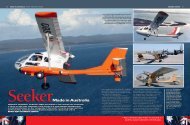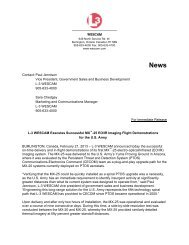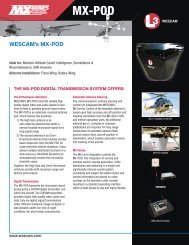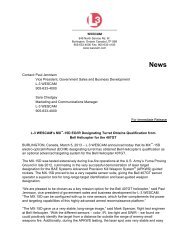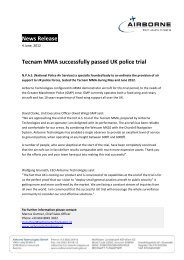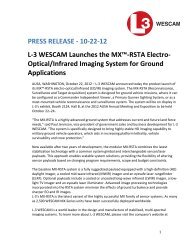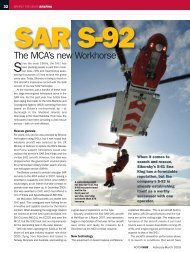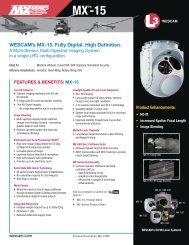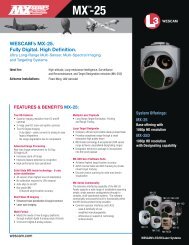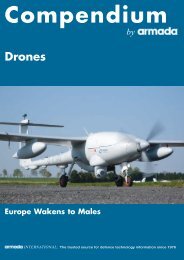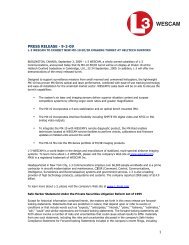Merlin's Second Coming - Wescam
Merlin's Second Coming - Wescam
Merlin's Second Coming - Wescam
You also want an ePaper? Increase the reach of your titles
YUMPU automatically turns print PDFs into web optimized ePapers that Google loves.
AIRFRAME UPGRADES<br />
Merlin’s<br />
second coming<br />
A comprehensive capability<br />
sustainment programme is<br />
intended to bring the bulk<br />
of the Royal Navy’s Merlin<br />
helicopter fleet up to a<br />
new HM2 standard,<br />
Richard Scott reports.<br />
T he<br />
last decade has seen the Royal Navy<br />
(RN) progressively get to grips with the<br />
immense capability and versatility afforded<br />
by the Merlin HM1 helicopter.<br />
Based on the AgustaWestland<br />
EH101/AW101 platform, but delivered as<br />
an integrated weapons system under the<br />
prime contractorship of Lockheed Martin UK<br />
Integrated Systems (LM UKIS), Merlin was<br />
originally procured to operate from aircraft<br />
carriers and Type 23 frigates and to directly<br />
replace the venerable Sea King HAS6 in the<br />
open-ocean anti-submarine warfare (ASW) role.<br />
History has seen things turn out rather<br />
differently. For a start, the fast, deep-diving<br />
Soviet submarine threat that the Merlin was<br />
conceived to counter largely disappeared<br />
before the aircraft had even completed its<br />
protracted development programme.<br />
Instead, Merlin has found itself re-cast by the<br />
Fleet Air Arm (FAA) as a multi-mission maritime<br />
patrol helicopter, tasked to take on a much<br />
wider range of duties on the front line,<br />
including surface search, littoral ASW, antisurface<br />
warfare (ASuW), force protection,<br />
vertical replenishment and intra-theatre lift.<br />
In doing so, the HM1 has proved itself to be<br />
both adept and agile. The combination of the<br />
Selex Galileo Blue Kestrel surveillance radar,<br />
Orange Reaper electronic support measures<br />
(ESM), Link 11, Sonar 2089 active dipping sonar,<br />
AQS-903A acoustic processor and, aboard<br />
selected aircraft, the L-3 <strong>Wescam</strong> MX-15 EO/IR<br />
device, means it can ‘swing’ roles in flight and<br />
truly multi-task to meet the demands of the<br />
force commander.<br />
DESIGN SATURATION<br />
Yet while the Merlin mission system has been<br />
described as giving its two rear-cabin crew<br />
capabilities tantamount to those of an ‘airborne<br />
frigate’, its early 1990s origins – right at the end<br />
of the bespoke mil-spec computing era – have<br />
seen it increasingly left behind by accelerating<br />
technological change.<br />
As a result, the mission system has reached<br />
‘design saturation’, being encumbered by a<br />
tightly coupled hardware/software design,<br />
vintage 80x86 processors, obsolete<br />
programming languages, an outdated humanmachine<br />
interface (HMI) and an inability to<br />
easily accept new functionality and plug-ins.<br />
The corollary is a high premium to<br />
introduce change, and progressively higher<br />
spares and support costs. This reflects the<br />
difficulties associated with maintaining 35<br />
separate processor types, eight legacy<br />
software languages and a highly bespoke<br />
operating system.<br />
To address this situation, plans began to<br />
take shape at the end of the 1990s for a Merlin<br />
Capability Sustainment Programme (MCSP)<br />
to resolve obsolescence issues in the HM1<br />
airframe, avionics and mission system to ensure<br />
availability and sustainment of the aircraft out<br />
to its nominal 2029 out-of-service date. ➡<br />
www.rotorhub.com Volume 29 Number 2 | March/April 2010 | Defence Helicopter 21
22<br />
AIRFRAME UPGRADES<br />
Left: Merlin HM2 will introduce brand new tactical mission consoles featuring 60cm widescreen colour displays. (Photo: Lockheed Martin)<br />
Right: Compare and contrast with the existing mission displays. (Photo: Richard Scott/NAVYPIX)<br />
In addition, it was planned at the outset<br />
to embody a number of ‘aspirational’<br />
enhancements as part of the programme, chief<br />
amongst them being a defensive aids suite<br />
(DAS), a permanent EO/IR fit and the<br />
integration of an anti-surface guided weapon.<br />
An 18-month assessment phase kicked off in<br />
June 2002, with LM UKIS and AgustaWestland<br />
evaluating obsolescence issues and capability<br />
upgrades for the aircraft in order to improve<br />
performance and reduce through-life costs.<br />
This work, by then known as ‘Merlin<br />
Capability Sustainment Plus’, culminated in a<br />
proposal for demonstration and manufacture<br />
submitted to the Ministry of Defence in<br />
late 2004.<br />
FINAL CONTRACT<br />
One outcome of this exercise was to prioritise<br />
what could and could not be implemented<br />
within the programme budget. The wished-for<br />
capability enhancements constituting the<br />
‘Plus’ element of the project did not make<br />
the final cut – rather, the MCSP would<br />
emphasise sustainment by introducing a<br />
more open system architecture to mitigate<br />
existing and manage future obsolescence<br />
impacts, substantially reduce through-life<br />
costs, and offer a growth path to future<br />
technology upgrades.<br />
Following exhaustive and, in their later<br />
stages, somewhat fraught negotiations,<br />
LM UKIS, as MCSP prime contractor, was in<br />
December 2005 awarded a $1.15 billion<br />
contract by the MoD to bring 30 Merlin HM1<br />
aircraft up to an improved HM2 standard.<br />
The contract included an option for the<br />
modernisation of up to eight additional aircraft<br />
and mission systems. Although the RN was<br />
keen to exercise this option, budget pressures<br />
ultimately conspired against it.<br />
Lockheed Martin claims that the investment<br />
in MCSP will deliver an overall cost saving in<br />
excess of $770 million through the avoidance<br />
of obsolescence, and is also forecast to lead to<br />
savings in support costs in excess of $115<br />
million. At the same time, it will leave the<br />
RN with an aircraft offering the intrinsic<br />
adaptability and flexibility to accommodate<br />
future capability insertions.<br />
At the point of contract, the first re-worked<br />
aircraft was due for delivery in 2012, with entry<br />
into service following in 2013. Four years on,<br />
LM UKIS’s MCSP programme director Trevor<br />
Watkins says the programme ‘remains firmly<br />
on track to deliver against the schedule set<br />
out in 2005’.<br />
ADVANCED INSTALLATION<br />
In terms of embodiment, the key features of<br />
the MCSP comprise the installation of new<br />
NVG-compatible cockpit avionics (based on<br />
seven 1024x768 pixel XGA multifunction flatpanel<br />
displays), a new navigation suite (with<br />
dual attitude, heading and reference system,<br />
embedded GPS/inertial navigation system,<br />
standby GPS and a new air data computer), an<br />
open architecture mission system, a substantial<br />
uplift in tactical management system<br />
processing capability, and new tactical<br />
management software.<br />
In parallel, the Merlin HM2 is receiving an<br />
improved Blue Kestrel surveillance radar<br />
(incorporating a new digital signal processor<br />
conferring SAR/ISAR modes and improved<br />
track-while-scan performance), a revised sonics<br />
processing suite from Thales (featuring new<br />
shallow-water detection and tracking<br />
algorithms, a common acoustic processor to<br />
handle both active dipping sonar and<br />
sonobuoy processing, and a digital VHF<br />
sonobuoy receiver), and a new solid-state<br />
DiRECT HR mass storage and recording system<br />
from Saab Avitronics.<br />
New tactical mission consoles are installed in<br />
the rear cabin, using large flat-panel colour<br />
screens, drop-down menus and Windows-style<br />
display formats to reduce operator workload<br />
and provide a far more intuitive HMI.<br />
‘The dual 30cm displays used in the current<br />
HM1 consoles are being replaced by a Barco<br />
60cm (1920x1200 pixel) widescreen colour<br />
display, a 30cm (1024x768 pixel) interactive<br />
display unit and a 30cm (1024x768 pixel)<br />
touch-screen control unit,’ Watkins said.<br />
‘We want the operator to benefit from a<br />
much richer HMI. Avoiding operator overload is<br />
a key issue – given the power of modern<br />
Defence Helicopter | March/April 2010 | Volume 29 Number 2 www.rotorhub.com
processing, the operator is the bottleneck.<br />
Our aim has been to engineer a system<br />
where it is far more straightforward for the<br />
observer or crewman to access and interpret<br />
actionable information.’<br />
To that end, an RN observer has been<br />
embedded with the contractor’s development<br />
team. ‘This was enormously beneficial,’ said<br />
Watkins, ‘because rather than have engineers<br />
design the interface, we had a front-line user<br />
telling us how the operator would want the<br />
HMI menu sequences and display formats<br />
to function.’<br />
Lockheed Martin’s Owego operation is<br />
supplying a new tactical management<br />
computer with embedded digital map,<br />
based on multiple PC/104 processor cards<br />
communicating via a tactical Ethernet switch.<br />
This runs applications software, atop CORBA<br />
middleware, on Green Hills’ Integrity secure<br />
real-time operating system.<br />
MCSP also covers modifications to the<br />
Merlin Training System, centred on the type’s<br />
main operating base at RNAS Culdrose in<br />
Cornwall. CAE is under contract for the<br />
upgrade of the full mission cockpit dynamic<br />
simulator, the cockpit procedural trainer and<br />
two (out of the three existing) Merlin HM1 rear<br />
crew trainers.<br />
FEELING THE HEAT<br />
One change to the MCSP programme since<br />
contract award has seen the shelving of plans<br />
to retrofit helicopter electro actuation<br />
technology (HEAT) to replace existing<br />
hydraulic systems.<br />
Originally developed by AgustaWestland<br />
and industry partners BAE Systems and<br />
Claverham using a mix of MoD and corporate<br />
funding, the HEAT system was planned to<br />
introduce brushless electric motor actuators for<br />
both the main and tail rotors. According to<br />
AgustaWestland, the replacement of simplex<br />
mechanical flying controls with quadruplex<br />
electronic/mechanical systems would allow<br />
complex hydraulics to be removed from the<br />
AIRFRAME UPGRADES<br />
The Merlin HM1 – seen here during the RN’s<br />
‘Orion 08’ deployment to the Indian Ocean – has<br />
seen its mission remit broadened since it entered<br />
operational service in March 1999. (Photo:<br />
Richard Scott/NAVYPIX)<br />
aircraft, reducing weight and maintenance<br />
costs and improving safety.<br />
A ground rig was built at AgustaWestland’s<br />
Yeovil factory in early 2005 for component<br />
testing, and Merlin air vehicle RN01 was<br />
subsequently modified for HEAT trials.<br />
However, technology demonstration efforts ➡<br />
www.rotorhub.com Volume 29 Number 2 | March/April 2010 | Defence Helicopter 23
24<br />
AIRFRAME UPGRADES<br />
UORs bring enhancements to Merlin force<br />
The Merlin DAS capability, developed to meet a UOR for operations in the Northern Arabian<br />
Gulf, was introduced to service in early 2009. (Photo: Lockheed Martin)<br />
IN ADVANCE OF THE MCSP<br />
programme, recent operational<br />
demands have resulted in a number<br />
of the RN’s existing Merlin HM1<br />
helicopters becoming the beneficiary<br />
of enhancements introduced as urgent<br />
operational requirements (UORs) to<br />
reflect the current pattern of operations.<br />
Concern over the man-portable<br />
surface-to-air missile threat in the Northern<br />
Arabian Gulf (NAG) operating area saw a<br />
UOR raised in 2007 for the integration of a<br />
DAS in a pool of four aircraft modified for<br />
NAG operations.<br />
CONTRACT AWARD<br />
LM UKIS was in January 2008 awarded<br />
a $10.8 million contract to design,<br />
develop, trial and certify the DAS system,<br />
incorporating the BAE Systems AN/AAR-57<br />
Common Missile Warning System, the<br />
same company’s AN/ALQ-157 IR jammer<br />
and an AN/ALE-47 Countermeasures<br />
Dispensing System to eject IR flares.<br />
The DAS development and proving<br />
programme was supported by<br />
AgustaWestland (EMC and flight testing),<br />
QinetiQ (which performed flare carriage,<br />
release and jettison trials, RF environment<br />
generator testing and effectiveness trials),<br />
the Defence Science and Technology<br />
Laboratory, Petards Joyce-Loebl and the UK<br />
Air Warfare Centre. All test and evaluation<br />
activities were completed in December<br />
2008, and following release to service, the<br />
first DAS-equipped aircraft was delivered to<br />
the RN just 13 months after contract award.<br />
Under a second UOR, selected aircraft<br />
have received a naval full motion video<br />
(FMV) capability which enables EO/IR<br />
imagery from the L-3 <strong>Wescam</strong> MX-15<br />
system (a pool of which are rotated across<br />
the Merlin fleet) to be downlinked to<br />
remote platforms. This capability, also<br />
introduced to service in early 2009, is<br />
believed to have been led by LM UK<br />
working together with Cobham Aviation<br />
Services (electrical installation), Ultra<br />
Electronics (data link) and QinetiQ (test and<br />
trials activities). RN sources suggest four<br />
FMV kits have been delivered.<br />
Other UORs introduced to the front line<br />
over the last 18 months include a two-way<br />
Bowman radio communications system,<br />
additional armour protection for aircrew, a<br />
fast roping system, and the M3M 0.50 calibre<br />
heavy machine gun for force protection. In<br />
addition, Teledyne Reynolds was in late 2008<br />
contracted to manufacture a quantity of<br />
fittings to allow for the mounting of the<br />
MX-15 EO/IR system across the Merlin HM1<br />
forward fleet.<br />
using RN01 revealed issues concerning the<br />
reliability of the main rotor actuators, and as a<br />
result of attendant concerns over technical<br />
maturity and risk, the decision was taken in late<br />
2007 to drop HEAT from the MCSP programme.<br />
Instead, an alternate solution to flight control<br />
computer obsolescence has been adopted that<br />
retains the existing computer, but manages<br />
obsolescence through a programme of new<br />
design, qualification and production<br />
embodiment. Meanwhile, money saved by<br />
cancelling the HEAT upgrade has been reappropriated<br />
for initial spares provisioning.<br />
INTENSIVE INTEGRATION<br />
According to Watkins, the MCSP programme<br />
is now well into an intensive systems<br />
integration phase.<br />
‘In the key areas of software development<br />
we now have both air vehicle management<br />
and tactical management software releases<br />
coming out onto the rigs,’ he said. ‘We have also<br />
started to receive early phase subsystem<br />
deliveries – either “B” models or functional<br />
equivalent units – to support system<br />
integration activities.’<br />
The integration task is distributed across<br />
nine separate land-based development<br />
facilities: four software development test<br />
facilities (SDTFs) at Lockheed Martin’s Havant<br />
premises; a further three SDTFs at BAE Systems<br />
AeI in Yeovil (the former Aerosystems<br />
International business is taking responsibility<br />
for parts of both the aircraft management<br />
computer and tactical management computer<br />
software); one tactical system integration rig<br />
(TSIR) at Havant; and a full system integration<br />
rig (FSIR) at AgustaWestland in Yeovil. A<br />
common test system is employed across all<br />
of the lab-based rigs, ensuring a high level<br />
of repeatability.<br />
‘Software is developed and tested on the<br />
SDTFs before being brought together on the<br />
TSIR, which is very much at the core of the<br />
mission system integration work,’ explained<br />
Watkins. ‘It then migrates to the FSIR, which<br />
came on line at the end of 2009, for full<br />
integration with the aircraft’s avionics.’<br />
Tactical mission software – re-coded in<br />
Ada but making use of many existing<br />
algorithms from the HM1 – is being<br />
developed in three iterations, with various<br />
point releases in between. ‘We now have<br />
Release 2.0 on the rigs,’ said Watkins, ‘with an<br />
Defence Helicopter | March/April 2010 | Volume 29 Number 2 www.rotorhub.com
initial issue of Release 3.0 – which will deliver<br />
full capability including acoustics – planned for<br />
August 2010.’<br />
UP IN THE AIR<br />
AgustaWestland is meanwhile progressing<br />
avionics integration and qualification, together<br />
with the Merlin air vehicle modification<br />
programme. Production-standard avionics<br />
are in test, and wiring looms are now being<br />
installed on RN06, the first Merlin to fly in<br />
MCSP configuration.<br />
‘RN06 is now fully instrumented and will be<br />
the first aircraft to fly in December 2010,’ said<br />
Watkins. ‘Our aim is that it flies with a full-up<br />
mission system on board.’<br />
Ahead of this, preparations are ongoing for a<br />
radar de-risking trial in the second quarter of<br />
2010 using one of the Merlin HM1 aircraft<br />
resident at the MoD’s Boscombe Down flight<br />
test centre for trials and evaluation purposes.<br />
‘Installed performance is a risk, so we’re<br />
investing in a precursor trial to get the system<br />
The Havant-based tactical systems integration rig<br />
is very much at the core of MCSP mission system<br />
integration activities. (Photo: Lockheed Martin)<br />
airborne early on,’ Watkins explained. ‘We are<br />
then looking to extend this de-risk trial to test<br />
the acoustics suite.’<br />
To date, the MCSP programme has adhered<br />
to its schedule and hit key anchor milestones.<br />
‘We completed the system critical design<br />
review [CDR] in October 2008, the aircraft test<br />
readiness review in April 2009 [four months<br />
AIRFRAME UPGRADES<br />
early], and the training system CDR in October<br />
2009,’ said Watkins.<br />
The 30 Merlin HM1 helicopters slated for<br />
the HM2 upgrade will be progressively put<br />
through the MCSP modification cycle. An initial<br />
four airframes, including RN06, are now at<br />
AgustaWestland’s Yeovil facility in various<br />
stages of MCSP strip-down and build.<br />
‘The series retrofit programme commences<br />
in 2011, with each aircraft taking approximately<br />
nine months to upgrade,’ said Watkins. ‘There<br />
will be a staggered entry and exit to ensure<br />
that the forward fleet can maintain the<br />
requisite force elements at readiness, and<br />
we’re already working alongside various<br />
RN stakeholders to ensure the synchronisation<br />
of the aircraft modification programme with<br />
the introduction of the upgraded training<br />
system. At the same time, we’re working<br />
closely with the Integrated Merlin Operational<br />
Support contract to understand the condition<br />
and status of each aircraft as it comes in<br />
for upgrade.’ DH<br />
www.rotorhub.com Volume 29 Number 2 | March/April 2010 | Defence Helicopter 25



